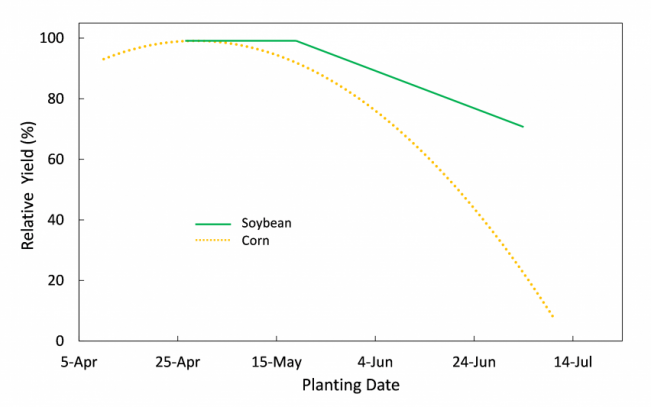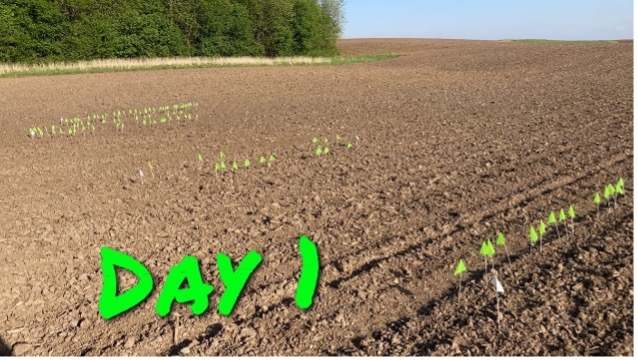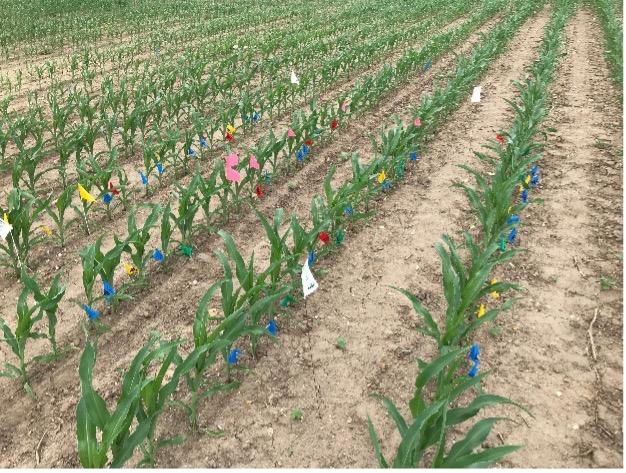STUDY SHOWS THE EARLY PLANTING YIELD ADVANTAGE IS REAL
“My hybrid and variety trials have generally shown the earlier corn or soybeans are planted, the higher their yield potential,” says AgriGold Agronomist Ron Roling who is based in northeast Iowa.
“Early planting allows soybeans to capture more sunlight, claiming more of their yield potential. Extending the corn growing season enables plants to accumulate more growing degree units (GDUs),” Roling explains.
PLANTING EARLY TO CAPTURE MORE YIELD
 “I would encourage everybody to start planting soybeans earlier,” Roling says.
“I would encourage everybody to start planting soybeans earlier,” Roling says.
Mark Licht, an associate professor and extension cropping systems specialist with Iowa State University Extension and Outreach, is also a proponent of early planting – within reason. “Most farmers can increase yield by three or four bushels an acre by planting early but not ultra-early,” he says in a blog.
A corn hybrid’s response to early planting is more varied. Therefore, Roling says farmers who plan to plant early should choose hybrids with strong emergence scores.
“When considering the differences between early-planting and late planting, yields are reduced less from planting too early compared to planting too late,” observes Licht. In an ideal world, he says corn and soybeans would be planted simultaneously.
BEST PRACTICES WHEN PLANTING SOYBEANS EARLY
“My No. 1 rule on early planting of soybeans is to use a seed treatment,” Roling says. “In fact, I would not recommend planting soybeans early without one.”
His next caution is to make sure the ground is fit for planting. Soils shouldn’t be overly saturated, soil temperatures should be trending higher, and farmers should be sure planting won’t cause compaction, Roling details.
His third piece of advice on early soybean planting is, “Don’t be afraid to back down populations on high-quality soils. In my opinion, we are still too high on our normal soybean populations.”
CONSIDER LOWERING SOYBEAN PLANTING POPULATIONS
Roling and other researchers have had success with lower planting populations on productive soils. Higher populations are still needed for poorer-quality soils to ensure canopy coverage and minimize weed escapes.
A five-year replicated plot study conducted by the Pennsylvania Soybean On-Farm Network found the number of pods per acre stayed the same regardless of whether the per acre seeding rate was 100,000 or 160,000. In other words, soybeans produced more pods per plant at lower population rates.
Final soybean stands of around 80,000 plants per acre achieved 90% of yield potential, details Del Voight, a senior agronomy educator for Penn State Extension who led the research project. That has implications for replant scenarios.
If replant conditions exist and plant populations are still at 80,000 plants per acre or higher and stands are relatively even, farmers should think twice about the wisdom of replanting, according to Voight.
Voight recommends farmers considering lower seeding rates use seed treatments, plant early and choose soybean varieties prone to branching.
AgriGold Agronomist Nick Frederking has spent time studying soybean varieties’ ability to flex and capitalize on that added branching. For more on that, check out this blog.
TIPS FOR EARLY CORN PLANTING
 Whereas most soybean varieties respond well to early planting, corn hybrids’
responses to early planting varies. To better gauge those differences, Roling tested one of AgriGold’s top-rated emergence products, one with moderate emergence characteristics and one with a slow emergence in 2022. He used flag testing to monitor
emergence and followed those hybrids through the growing season.
Whereas most soybean varieties respond well to early planting, corn hybrids’
responses to early planting varies. To better gauge those differences, Roling tested one of AgriGold’s top-rated emergence products, one with moderate emergence characteristics and one with a slow emergence in 2022. He used flag testing to monitor
emergence and followed those hybrids through the growing season.
“Hybrids with high emergence scores performed well, but those with slower emergence sacrificed some yield with earlier planting,” Roling explains. He emphasizes how important it is that farmers understand their hybrid selections and their
emergence scores and how they fit with their planting intentions.
Roling also advises farmers to make sure soils conditions are fit for planting and soil temperatures are trending warmer. “Avoid planting just before a cold rain,” he adds. Failure to do so can lead to imbibitional chilling and reductions in stand establishment and seedling vigor.
Seed treatments and a starter fertilizer are also smart additions with early planting, according to Roling, who prefers in-furrow applications of the latter.
“I think farmers will continue to pursue early planting, especially on soybeans – for good reason,” Roling says. “Don’t hesitate to reach out to your local AgriGold agronomist for information about early planting and what hybrids and planting populations might best fit that mold.”



